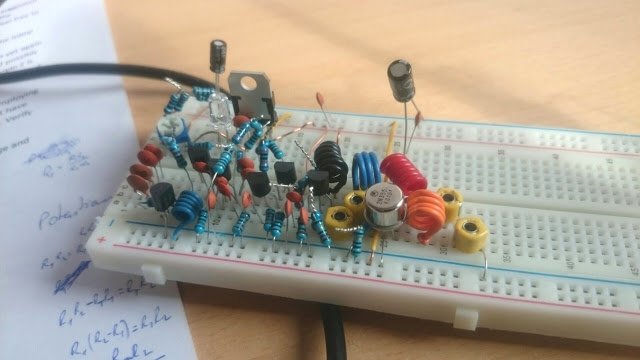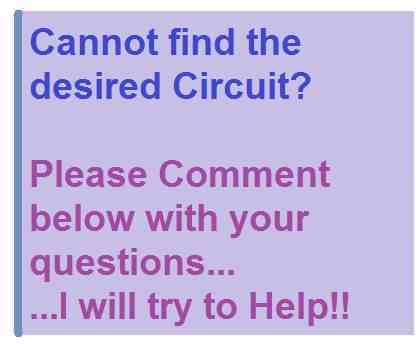How To Make A Long Range Rf Transmitter And Receiver
The proposed long range transmitter circuit really is very steady, harmonic costless design which you can use with standard fm frequencies between 88 and 108 MHz.
Technical Specifications of the Transmitter
This will likely cover 5km spectrum (long range). It includes an extremely consistent oscillator for the reason that you employ LM7809 stabilizer that is a 9V stabilized ability source for T1 transistor and for frequency realignment that may be reached by ways of the 10K linear potentiometer.
The output forcefulness of this long range rf transmitter is approximately 1W however may be more significant should you use transistors like KT920A, BLY8, 2SC1970, 2SC1971…
Transistor T1 is employed equally an oscillator stage to present a small ability steady frequency. To fine-tune the freq. utilise the 10k linear potentiometer this way: should you moderate, in the direction of ground, the freq. would probably decrease just when you fine-tune it in direction of + it would climb.
Essentially the potentiometer is needed only as a flexible power source for the a pair of BB139 varicap diodes.
Both of these diodes function as a changeable capacitor whilst you regulate the pot. By tweaking the diode capacitance the L1 + diodes circuit renders a resonance excursion for T1.
Feel gratis to employ transistors similar to BF199, BF214 all the same be careful not to use BCs. At this betoken you don't receive yet the long range fm wireless transmitter due to the fact that the electric power is fairly reduced, a maximum of 0.5 mW.
How it Works
The proposed transmitter circuit works in the post-obit manner:
E'er encase the oscillator stage in a metal guard to avoid parasite frequencies destabilizing the oscillating phase.
Transistors T2 and T3 functions equally a buffer stage, T2 equally a voltage amplifier and T3 as a current amp.
This buffer stage is vital for freq stabilization only because is a tampon circuit between the oscillator and the preamp and terminal amplifier. It happens to be renowned that bad transmitter layouts unremarkably change freq. whenever you alter the finalized phase.
Using this T2, T3 stage this won't occur again!
T4 is a preamplifier phase and is employed every bit a voltage power rf amplifier which enables information technology to produce acceptable power to the catastrophe T5 transistor stage.
As is demonstrated T4 carries a capacitor trimmer in its collector, this is definitely accustomed to return a resonance circuit designed to drive T4 to promote more than advantageous situations and do away with those undesirable harmonics.
L2 and L3 coils has to be at xc degrees perspective ane to another, this is to prevent frequency and parasite coupling.
The last phase of the long range rf transmitter is equipped with any rf power transistor containing no less than ane watt product ability.
Use transistors like 2N3866, 2N3553, KT920A, 2N3375, 2SC1970 or 2SC1971 should you wish to produce a professional fm transmitter with ample power to take care of an extended spectrum zone. Should you use 2N2219 you lot will definitely go a maximum of 400mW.
Make use of an effective heatsink for the T5 transistor because it becomes slightly warm. Make use of a reliable 12V/1Amp balanced supply of power.
How to Set-up the Transmitter
Begin by building the oscillator stage, solder a tiny wire to T1 10pF capacitor out and hearing a fm radio, tweak the 10k pot until it is possible to "hear" a blank disturbances or maybe if you connect an music base y'all could mind to the melodies.
With a 70cm cord it is possible to take care of a 2 – 3 meter region simply with the oscillator stage.
Next deport on and construct the remaining of the rf transmitter, utilize correct shielding as suggested in the above explanation.
As soon equally you lot have completed the transmitter blueprint, hook upwards the antenna or more than effectively a 50 or 75 Ω resistive load and brand use of this every bit a rf probe, feel gratis to utilise 1N4148 diode in place of the probe diode.
Fine-tune yet once again the 10k pot to favored freq. thereafter go to T4 stage and scale downward the initial collector trimmer for highest voltage signal on the multimeter.
After that conduct on with the subsequent trimmer and and so forth. Afterward that get back on the very first trimmer and readjust however again until you lot receive the maximum voltage on the multimeter.
For 1 watt rf power you could possibly ascertain a twelve to sixteen Voltage. The method is P (in watt) is equivalent to U2 / Z, wherein Z is 150 for 75Ω resistor or 100 for 50Ω resistor, nevertheless ane should proceed in mind that the proper rf ability is bottom.
Subsequently those modification, in case things are heading nicely hook up the antenna, keep on employing the rf probe, readjust once more all of the the trimmers right from T3.
Guarantee you don't accept harmonics, verify the Television receiver and radio set to make up one's mind if in that location exists fluctuations on the ring. Verify this in an alternative area, a long style away from the fm transmitter or antenna.
The unit is all set up up to be used for exchanging music, talks, chats across the suggested range and bands.
Circuit Diagram

All Inductors are air cored
L1 = five wounds / 23 SWG / 4mm silvered copper
L2 = vi wounds / 21 SWG / 6mm enamelled copper
L3 = iii wounds / xix SWG / 7mm silvered copper
L4 = 6 wounds / 19 SWG / 6mm enamelled copper
L5 = 4 wounds / 19 SWG / 7mm silvered copper
T1 = T2 = T3 = T4 = BF199
T5 = 2N3866 for 1Watt / 2SC1971, BLY81,or 2N3553 for 1.five to 2W power.
Feedback from Mr. Himzo (a dedicated follower of this website)
Hello Swagatam,
I have few questions about your long range fm transmitter.
Firstly about the shielding, what is the most simplest solution to avoid those "parasite frequencies"?
Secondly, what means those 1nF capacitors at the top? Can they be simple in parallel connection or they need to be separated to every transistor like in scheme?
Thirdly, I sent y'all a photo of transmitter, I didn't turn on amplifier role because my heatsink is coming. Where tin I put antenna for testing without amplifier (T5 phase)?
And lastly, how can I modulate those trimmers if I dont have plastic screwdrivers?
Cheers very very much, this is nifty project.
Your fan, Himzo.

Solving the Circuit Problem
Hello Himzo,
the simplest and the only style to shield the various sensitive stages is by using metal walls between the stages...
the 1nF capacitors should exist positioned exactly where these are indicated in the diagram.... the picture which yous take shown will never piece of work... transmitter circuits crave extreme care as far as their structure and positioning of the components are concerned.
You lot can never build a long range transmitter successfully on a breadboard, y'all will have to do it on a well designed PCB which should have a grounded track base of operations layout encompassing all the thinner tracks, only then you tin can expect the transmitter to work...that as well after careful optimization of the trimmers and past employing a compatible antenna.

Source: https://www.homemade-circuits.com/long-range-transmitter-circuit-2-to-5/
Posted by: johnsonbleanto1988.blogspot.com

0 Response to "How To Make A Long Range Rf Transmitter And Receiver"
Post a Comment